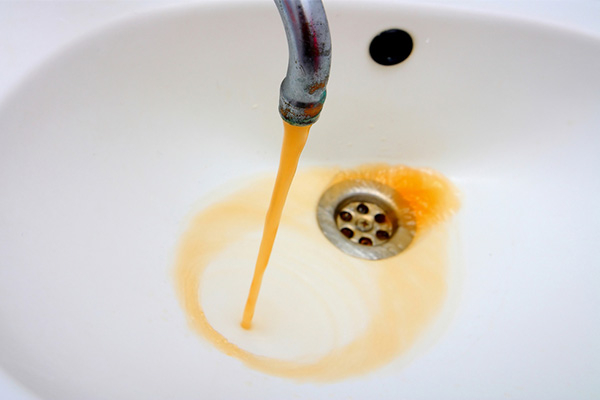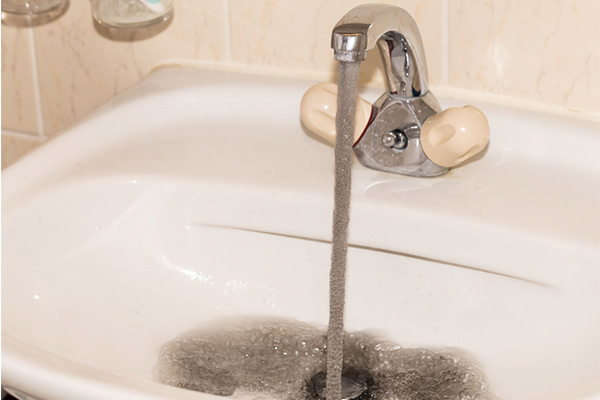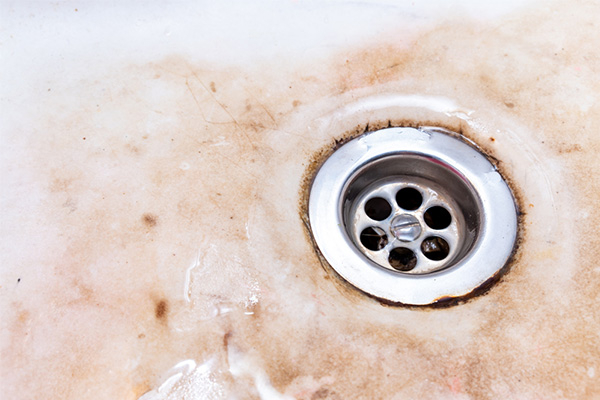Water Quality or Pressure Concerns#
Have you noticed discolored water, a different taste or smell to your water or decreased water pressure? Use the information below to determine the potential cause, steps you can take to resolve it and when to report it.
Please note, subtle discoloration or odors do not necessarily indicate your water is unsafe to drink. However, we recommend that you refrain from drinking discolored water until the source of the color/odor can be determined and the issue resolved. If the issue has not resolved after you’ve gone through these troubleshooting steps, or if you still have questions or concerns, please call 970-221-6700.
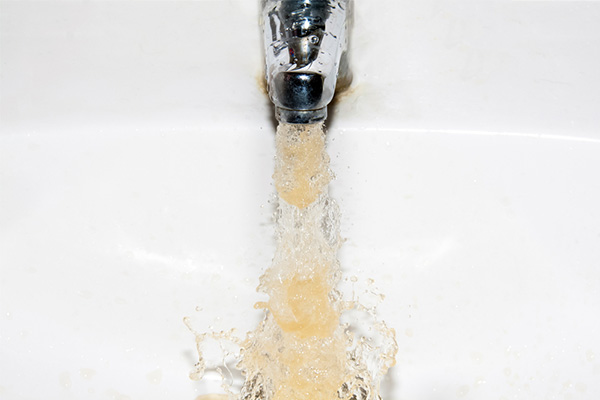
Discolored Water
Discolored water can be caused by your home plumbing, maintenance in your area or other water system activity in your neighborhood, such as fire hydrant use.

Taste or Smell
Taste and odor changes in drinking water can be caused by a variety of factors, including your home plumbing.
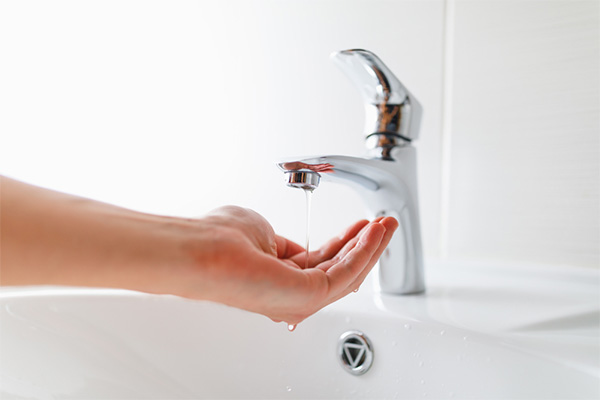
Water Pressure
If you have a water pressure issue, it's most likely related to your home plumbing. That said, water main breaks and other water system events can also cause temporary water pressure changes.
Discolored Water#
Follow the steps below to determine the potential cause, steps you can take to resolve it and when to report it.
Step 1: Compare hot and cold water.
- If only the hot water is discolored: The color is likely from your water heater or pipes. Your water heater may need to be flushed or serviced. Copper or iron pipes that connect the water heater and the faucet can also contribute color. Depending on what color your water is, you will have different steps to take (please see more details on specific colors later on this page).
- If only the cold water is discolored, or the color is appearing in both hot and cold: Go to Step 2.
Step 2: Check all faucets and toilets inside and outside your home.
- After flushing for 5-10 minutes, if you see discoloration at some faucets, but not all: You may have an issue with the plumbing in specific locations in your home, not with the water coming into your home from the water main in the street.
- If you see discoloration at all faucets, including toilets: The color is not from a specific location in your home. Go to Step 3.
Step 3: Run a cold water faucet for 5-10 minutes.
- If running the water does not resolve discolored water: A water event may have happened in your area. Any waterline repairs and/or flushing in the area may cause your water to appear cloudy or discolored for a short time. This water is not harmful, though it may stain laundry. It's also safe to use on plants and landscape. Wait 30 minutes and repeat. If it still doesn’t clear, you can call 970-221-6700 to report your concerns.
- If the discoloration clears quickly after you run the water: There may be an issue with the plumbing in your home. If your home has older plumbing, you may often see discolored water when you turn on the tap after it hasn't been used for a while.
Read more below about specific colors you're seeing in the water.
-
![yellow, brown water coming out of faucet]()
There's color when you first turn on the water, but it clears after you run it. This is potentially due to old fixtures and/or plumbing inside your home. You can run your faucet as needed to bring in freshwater from the water main, purchase a water filter or consider replacing old fixtures and possibly your pipes.
The color stays, even after you run a cold faucet. This is typically due to a temporary water event in your area. Discoloration can happen when the flow of water suddenly changes in your area, causing natural sediments inside water pipes to be stirred up. It may take a few hours for the discoloration to clear. Once nearby work is complete, remove faucet aerators/filters and run the cold water for 5-10 minutes (usually the water clears within a few minutes, if flushing in the area is complete). If it does not clear, turn the water off and wait another 30 minutes before running it again. While the water is discolored, limit your hot water use and avoid washing light-colored laundry. If you use a water filter, wait until the water is clear before you use it. When the water does clear, flush your faucets by running them for a minute or two, and clean faucet aerator screens if particulates or sediment are restricting flow.
-
![black water coming out of faucet]()
Blue or green water: This is commonly caused by new copper plumbing or existing copper plumbing that is corroding. Run your faucet as needed to bring in fresh, uncolored water from the water main.
Black or gray water: Rubber may be breaking down in your plumbing gaskets, or carbon pieces are leaking out of your household water filters. Replace both as needed. You also may have iron or manganese adding color from old corroded pipes.
White water or milky water: Fill a glass of water and wait three minutes. If the water clears from the bottom to the top, the discoloration is just tiny, harmless air bubbles in the water. These air bubbles can form when there is excess air in the water. If hard white particles remain, or you find them clogging your aerator screens, the plastic dip tube inside your water heater may have failed, or there's mineral buildup inside the tank. Your water heater may need maintenance or repair if white particles remain.
-
![pink mold slime in sink drain]()
This is caused by bacteria that grow in moist environments. The bacteria commonly form in sink drains, create rings around toilet bowls or appear on surfaces in the shower. These “biofilms” are like plaque that forms on your teeth, and you'll want to clean toilets, sinks and other moist surfaces regularly to keep them under control. Mechanically cleaning with a soft bristle brush and a disinfecting solution (such as 10% bleach solution) is often required. Control humidity in your home and ensure good ventilation in bathrooms that have showers. Mold can also grow in these humid locations.
Taste or Smell#
Step 1: Compare hot and cold water.
- If hot smells bad, but cold is normal: Your home's water heater or hot water plumbing may be the source. Your water heater may need maintenance. Steam rising from your sink drain can also cause odors (see Step 2).
- If only the cold water tastes or smells bad, or both hot and cold are abnormal: Continue to Step 2.
Step 2: Fill a clean glass with water and take it into another room to see if the taste or odor persists.
- If the taste or odor disappears when you move away from the sink: You have a sink drain odor issue. The drain trap or garbage disposal may need cleaning. If a drain odor persists throughout your entire home, there could be a sewer issue in your home or on your street.
- If the taste or odor stays with the glass when you move away from the sink: Continue to Step 3.
Step 3. Check all faucets inside and outside your home.
- If the taste or odor is present at some faucets, but not all: Your plumbing is the likely source of the taste or odor. Remove, clean and disinfect faucet aerators or screens and run faucets to bring in freshwater from the water main. For some homes with older plumbing, the first use of water after sitting in the pipes for several hours may tend to have a taste or odor but clears with fresh water.
- If the taste or odor is at all faucets inside and outside your home: Continue to Step 4.
Step 4: Flush a cold water faucet for one to two minutes to see if the taste or odor resolves.
- If the taste or odor goes away after you run the water: Your plumbing is the likely source of the taste or odor. Remove and clean faucet aerators or screens and run faucets to bring in fresh water from the water main. For some homes with older plumbing, the first use of water after sitting in the pipes for several hours may tend to have a taste or odor but clears with fresh water.
- If running the water does not improve the taste or odor: Follow the troubleshooting steps below for specific tastes or odors.
-
Earthy or musty: If your water tastes or smells earthy or musty, remove, clean and disinfect aerator screens and run faucets to see if the taste or smell clears. If the taste or smell persists in all cold water faucets, even after you run the water for a few minutes, report the issue to 970-221-6700.
Sulfur or rotten eggs: A sulfur or rotten egg odor in drinking water is typically caused by water heater issues or bacteria in sink drains. Clean your sink drains and garbage disposal. If only the hot water smells, you may need to service the water heater. If all cold water faucets smell and the odor doesn't clear after you run your faucets for two to three minutes, contact 970-221-6700.
Metallic or bitter: Metallic and bitter tastes are often due to old iron pipes inside homes. Remove and clean aerator screens, and run faucets for a few minutes to see if the taste or odor clears.
Other tastes or odors: If your water smells like something not listed above, report the issue to 970-221-6700.
Water Pressure#
Low water pressure or flow
If your water pressure or flow changes (either suddenly or gradually), check all faucets inside and outside your home and compare hot and cold water.
- If only the hot water has lower flow, and cold water is normal: Examine your water heater for leaks or other failures. Clean hot water faucet screens (aerators) and showerheads. Call a plumber or your property manager if you can't address the problem.
- If some faucets still have normal flow, while other faucets have lower flow: This indicates a plumbing issue at specific faucets in your home. Remove any filters or faucet screens (aerators) and check for blockages. Check that all water valves inside your home are all the way open. Listen for running water sounds that may indicate a leak. If you have older galvanized plumbing, you may have restricted flow from pipe corrosion. Call a plumber or your property manager if you can't address the problem.
- If flow is reduced at all faucets, including outside hose spigots: Remove and clean aerator screens to see if flow improves. If you have a pressure-reducing valve (PRV) or whole house filter, make sure it's still working. If you have older galvanized plumbing in your home, you may have restricted flow from corrosion. Check for visible leaks inside and outside the home. If you are in an apartment or condo building, report the issue to your property manager.
No water, zero percent flow
If you have no water at all, check all faucets, including those in the lowest level of your home. Compare hot and cold water. If you are completely out of water at all cold water faucets, check your front door for a shutoff notice and look outside to see if crews are working nearby. If you are in a multifamily property, notify your property manager so they can determine if the issue is occurring in all units inside the building. If cold water has normal flow, but you have no hot water, contact a plumber or your property manager.
Fluctuating water pressure
Pressure fluctuations are normal and can come from daily or seasonal changes in water use. In residential neighborhoods, daily peak use is before and after normal business hours, as people use water to get ready for work or school and as people do chores in the evening. Seasonal peaks occur when people are watering their gardens in the summer. During peak use periods, you may have lower water pressure. If you're concerned, monitor your pressure and report unusual fluctuations.
High water pressure
Report high water pressure concerns by calling 970-221-6700. It's possible that your home is supposed to receive higher pressure due to its location and elevation. And while it's rare, a temporary spike in water pressure can occur if there is an issue in the water distribution system. If necessary, we can test the pressure at your meter. If pressure is within the expected range, we consider your pressure to be normal and can't change the pressure for you. If the pressure bothers you, you may need to install (or repair) a pressure-reducing valve (PRV), which is required by plumbing code if your home receives higher than 80 psi. If water pressure is out of normal range, we will investigate and resolve the problem.
Did You Know?
You can save water when washing smaller loads by selecting the setting for the corresponding water level.
Pre-cooling your home before 2 p.m. during the summer and coasting through the on-peak hours can save money on your utility bill.
You can monitor your energy and water use with our online portals.
